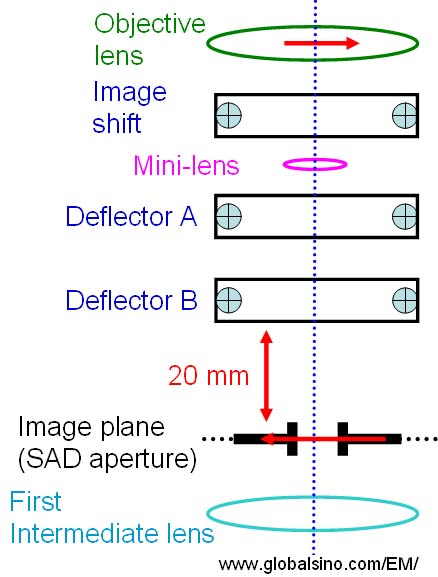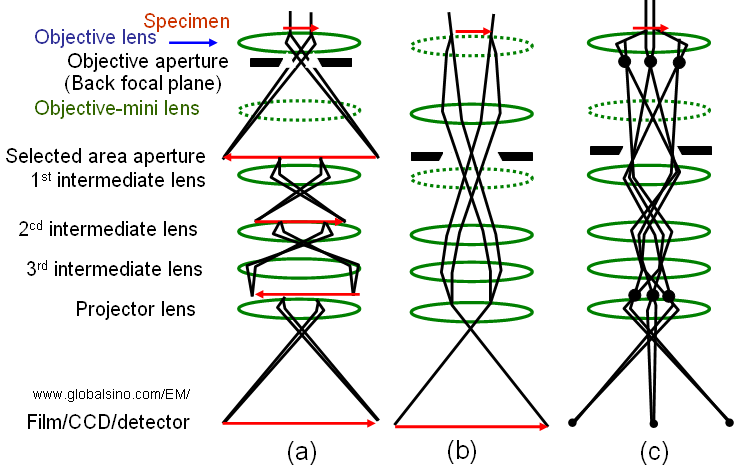=================================================================================
In selected area diffraction (SAD) technique, an aperture (called selected area aperture) is introduced into the image plane of the objective lens to select an area so that we can limit the region which generates the diffraction pattern. Note that the image plane of the objective lens is also the first image plane
in the TEM system. In this case, the SAD aperture is used to exclude parts of the area being viewed so that we can make sure the diffraction pattern originates from a small, specific area. Figure 3710a shows the normal position of the SAD aperture in TEM columns. Furthermore, this aperture is also applied to reduce both the area and intensity of the beam contributing to a diffraction pattern.

Figure 2761a. Schematics illustrating the position of the SAD aperture in TEM.
Figure 3710b (a) shows the principle of magnifying an image (Normal-Mag mode). A transmitted image of the specimen is first formed and magnified by the objective lens, and then is magnified further by two to four lenses, including an objective lens, intermediate lenses, and a projector lens. As shown in Figure 3710b (b), at extremely low magnification (e.g. used for survey of interest), the image is formed by the OM (objective-mini) lens, intermediate lenses, and projector lens. The Diff mode in Figure 3710b (c)presents an electron diffraction pattern. In the Normal-Mag mode, the focus of the 1st intermediate lens is adjusted to the image plane of the objective lens where a selected area aperture is located. However, in the Diff mode, the focus of the 1st intermediate lens is adjusted at the back focal plane of the objective lens. Table 3890 lists the status of the lenses and apertures in different operation modes.

Figure 3710b. (a) Normal-Mag mode, (b) Low-Mag mode, and (c) Diff mode. The dashed-lenses are turned off in the relevant operation mode.
Table 3710. Status of the lenses and apertures in different operation modes*.
Lens |
|
|
|
|
On |
Off |
On |
Objective aperture (back focal plane)
|
Normally use |
Normally not use |
Normally not use |
|
Off |
On |
Off |
|
Normally not use |
Either use or not use |
Either use or not use |
Focus of 1st intermediate lens |
At the image plane of the objective lens |
- |
At the back focal plane of the objective lens |
|
On |
Off |
On |
|
On |
On |
On |
|
On |
On |
On |
|
On |
On |
On |
* "Normal-Mag mode" includes normal and high magnifications for HRTEM; "Low-Mag mode" includes very low magnifications, which is used for specimen survey; and "Diff mode" is for electron diffraction analysis. |
The drift and jump of EEL spectra or images can be induced by different reasons:
i) Induced by charging as a result of the exposure to the electron beam:
i.a) The EEL spectrum or image first gradually drifts in one direction when the charge is building up;
i.b) It suddenly jumps in the opposite direction when the charge dissipates with a discharge.
If something is really charging, then increasing the beam current while keeping the illuminated area on the viewing screen the same should lead to an increased rate of drift.
A small selected area diffraction (SAD) aperture can be used in order to determine whether the charging occurs in the camera chamber or in the GIF. The small SAD aperture ensures that all the electrons enter the GIF and none can hit and charge any parts in the camera chamber. If the charging continues, then it must be in the GIF. Otherwise, it should be in the camera chamber if it stops.
ii) Induced by unstable high voltage of the electron beam.
|
